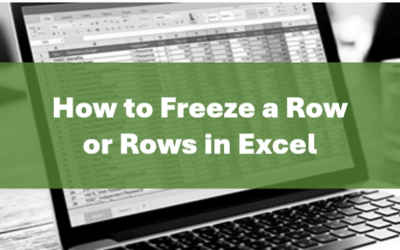Using a Keyboard to Navigate and Select in Task Panes
by Avantix Learning Team | Updated August 26, 2021
Applies to: Microsoft® Word® 2010, 2013, 2016, 2019 and 365 (Windows)
This article is the third in a series of navigating and choosing commands in Word, Excel and PowerPoint using a keyboard. In this instalment, we'll review working with task panes. You can use these keyboard navigation and selection strategies in Microsoft Word, Excel, PowerPoint, Access, Outlook, Project and Publisher.
A task pane is a window in a Microsoft Office program that provides more options or commands. In Microsoft Word, examples include the Styles task pane and the Find or Navigation task pane. Some task panes open automatically when you select a specific command. You can also open a task pane using a keyboard shortcut or the Ribbon.
Recommended articles: Navigating the Ribbon in Word, Excel and PowerPoint Using a Keyboard and Navigating and Selecting in Dialog Boxes in Word, Excel and PowerPoint Using a Keyboard
Do you want to learn more about Microsoft Word, Excel or PowerPoint? Check out our virtual classroom or live classroom courses >
Below is the Styles task pane in Microsoft Word:
Controlling the focus
In order to work with the keyboard in a task pane, the task pane must have the focus (or be active).
If a task pane is open, you can switch to it by pressing F6 repeatedly until the task pane has the focus.
Cycling between areas in the program window
To move the focus to select the following areas of the window, keep pressing F6. This changes the focus in a clockwise direction as follows:
- Active tab of the Ribbon
- The document
- Task pane
- Another task pane (if open)
- Status bar at the bottom of the window
You can cycle in a counter clockwise direction by pressing Shift + F6.
Navigating and selecting in task panes
Once a task pane has the focus, you can use the keyboard to navigate and select:
- Move the focus between the task pane elements or areas by pressing Tab to move forward or Shift + Tab to move backward.
- Use the up and down arrow keys to navigate within a gallery area in a task pane that has the focus (such as the Styles gallery in the Styles task pane in Word).
- To select the first or last item in a gallery, press Home or End.
- Activate a command by pressing Enter.
- Press Shift + F10 to open a shortcut menu (comparable to right-clicking on an item). Use up and down arrows keys to navigate the menu and press Enter to select a menu item.
- Press Ctrl + Spacebar to display the menu for the task pane.
Closing a task pane
To close a task pane:
- Press F6 until the task pane has the focus.
- Press Ctrl + Spacebar. A drop-down menu appears in the title bar of the task pane.
- Press C to close. You could also use the down arrow key until the command is selected and then press Enter.
Resizing a task pane
To resize a task pane:
- Press F6 until the task pane has the focus.
- Press Ctrl + Spacebar. A drop-down menu appears in the title bar of the task pane.
- Press S to resize. You could also use the down arrow key until the command is selected and then press Enter.
- Use the arrow keys to resize the task pane. Use Ctrl + arrow keys to resize one pixel at a time.
- When you finish resizing, press Escape.
Moving a task pane
To move a task pane:
- Press F6 until the task pane has the focus.
- Press Ctrl + Spacebar. A drop-down menu appears in the title bar of the task pane.
- Press M to move. You could also use the down arrow key until the command is selected and then press Enter.
- Use the arrow keys to move the task pane. Use Ctrl + arrow keys to move one pixel at a time.
- When you finish moving, press Escape.
Learning to use the keyboard to navigate and select can save time but is also particularly useful for those working with laptops or any user that has difficulty using a mouse.
This article was first published on December 31, 2014 and has been updated for clarity and content.
Subscribe to get more articles like this one
Did you find this article helpful? If you would like to receive new articles, join our email list.
More resources
3 Strikethrough Shortcuts in Microsoft Word
14+ Word Selection Shortcuts to Quickly Select Text
How to Create a Table of Contents in Microsoft Word
Related courses
Microsoft Word: Intermediate / Advanced
Microsoft Word: Designing Dynamic Word Documents Using Fields
Microsoft Word: Long Documents Master Class
Microsoft Word: Accessible Word Documents
Microsoft Excel: Intermediate / Advanced
Our instructor-led courses are delivered in virtual classroom format or at our downtown Toronto location at 18 King Street East, Suite 1400, Toronto, Ontario, Canada (some in-person classroom courses may also be delivered at an alternate downtown Toronto location). Contact us at info@avantixlearning.ca if you'd like to arrange custom instructor-led virtual classroom or onsite training on a date that's convenient for you.
Copyright 2024 Avantix® Learning
You may also like
How to Replace Zeros (0) with Blanks in Excel
There are several strategies to replace zero values (0) with blanks in Excel. If you want to replace zero values in cells with blanks, you can use the Replace command or write a formula to return blanks. However, if you simply want to display blanks instead of zeros, you have two formatting options – create a custom number format or a conditional format.
What is Power Query in Excel?
Power Query in Excel is a powerful data transformation tool that allows you to import data from many different sources and then extract, clean, and transform the data. You will then be able to load the data into Excel or Power BI and perform further data analysis. With Power Query (also known as Get & Transform), you can set up a query once and then refresh it when new data is added. Power Query can import and clean millions of rows of data.
How to Freeze Rows in Excel (One or Multiple Rows)
You can freeze one or more rows in an Excel worksheet using the Freeze Panes command. If you freeze rows containing headings, the headings will appear when you scroll down. You can freeze columns as well so when you scroll to the right columns will be frozen.
Microsoft, the Microsoft logo, Microsoft Office and related Microsoft applications and logos are registered trademarks of Microsoft Corporation in Canada, US and other countries. All other trademarks are the property of the registered owners.
Avantix Learning |18 King Street East, Suite 1400, Toronto, Ontario, Canada M5C 1C4 | Contact us at info@avantixlearning.ca








